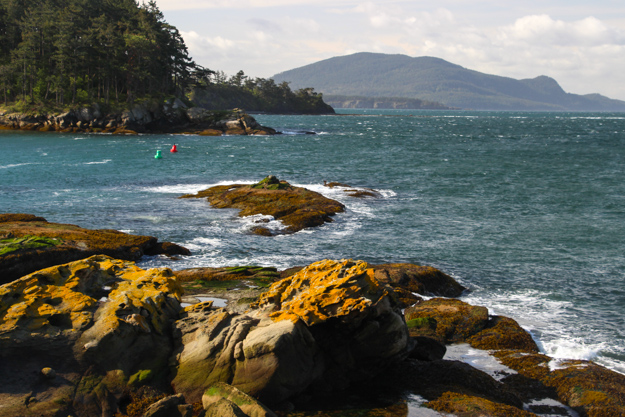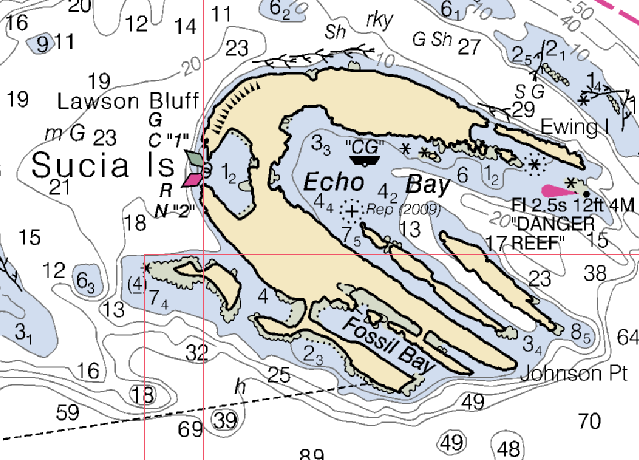It rains a lot in April is the ultimate statement of the obvious in the PNW, but in the last week it’s something that has often come to mind. We’ve had most of the kinds of rains we tend to have: light rain, heavy rain, misty rain, foggy rain, sideways rain, pelting rain, drippy rain.
But this is something we just have to get used to. I like to say “April showers bring May flowers” is really “April showers bring more May showers.” The concept of flowers not until May is a reminder to me of how wrong this expression is (it’s probably from the East Coast) – here we get flowers in March! And May will still have plenty of rain, although probably less than April.

It’s not all rain though – we’ve also had some sun, and plenty of wind. We’ve continued to do San Juans hikes most days, beach yoga during sun breaks, bird watching, photography, cooking, and plenty of reading. One of my favorite things about cruising is there’s always something to do.

Viewing the entrance to Sucia’s Shallow Bay during a 20 knot southwesterly.
Clark Island (near The Sisters islands, SE of Matia and NE of Orcas)
We’ve often passed Clark and Barnes Islands in Rosario Strait on the way to Sucia, not really even noticing them or thinking of them as a viable stopping point. But Clark Island has many WA Parks Department mooring balls, and some nice beaches. The main issue is the east side mooring balls are exposed to potential swells from shipping traffic. So we checked out the west side (between Clark and Barnes), where 3 mooring balls were available near a nice sandy beach.
There are moderate currents in here, so mooring ball pickup was more challenging than usual. However it’s surprisingly well protected from southeasterly wind. The 15 knot southeasterly in Rosario Strait that arrived later still reflected some waves into the anchorage making for bumpy conditions, but most wind was blocked and the wave fetch wasn’t too bad.

We’ve been on mooring balls a lot lately, and have nearly perfected our technique for a quiet night without the ball slamming the hull when current pushes us into it. We call this the “bow diaper.”
Matia Island
We’ve wanted to check out Matia for a long time now – probably 3 years. But whenever we’ve passed by in June or July it’s full – the west cove only fits 2 boats on mooring balls, with probably no room for anchoring. But Sunday it was empty – thanks to there not being any boats in the San Juans yet. The only problem was a northwest wind had sprung up, in the 15 knot range, and this pushed some pretty rolly fetch into the northwest facing cove. We knew it would be bumpy but decided to put up with it because we really wanted to go to Matia.
We went for the 1 mile loop hike around the island, and discovered the southeast facing cove on the island looks like it has plenty of room for anchoring (but no mooring balls) and beach access to the hiking trail. Next time in a northwest wind we would definitely prefer to try out anchoring there.

Our anchorage had a seal (or sea lion?) hanging out in the rocks just 50 feet from our boat. We think he was sleeping / napping, because he’d surface every 5-10 minutes in the exact same spot, look around, and then go back down.
That night was the worst, rolliest anchorage we’ve ever been in. With only 15 knots out of the northwest we had wind and current driven swells rolling into Matia’s Rolfe Cove – easily 1 – 2 foot waves at times. The currents swirling through the anchorage were strong enough to overcome the wind, turning our boat sideways and stern on to the swell at times. The boat heaved, pitched and rolled all at the same time. Bulkheads creaked, water bottles slid across counters, plates in the cabinets clinked – it was like we were sailing downwind in a rolly sea. We should’ve left, but the worst of it hadn’t started until 8pm or so. After a rough night of sleep we got out of there asap in the morning.

Keeping in mind waves always look smaller in photographs, this is far from the ideal anchorage (which would look flat and glassy calm, like a lake).
Sucia Island, Fossil Bay
Departing Matia we sailed just 2-3 miles over to Sucia. A strong wind warning was coming for Monday night thru Tuesday morning and we wanted to be in a much better anchorage than Matia.
We wanted to go to Shallow Bay, on the west side of Sucia – but the forecast was saying the SW wind would clock to the west later, and although Shallow Bay looks pretty protected, its entrance is to the west. Not having been to it before, we didn’t want to risk it. Fossil Bay is long, protected from the south, and looked blissfully calm.

Sucia Island, with Shallow Bay on the west and Fossil Bay in the southeast.
I’m discovering our San Juans cruising guides mention little about protection or swell directions in anchorages – I think perhaps this is because most people cruise here when those things aren’t a concern. So we attempt to deduce the conditions from anchorage shape, proximity to straits, and wind reports from the US, BC, WindyTy, and GRIBs in PredictWind.

Fossil Bay, Sucia. 2 other boats here. 4 total on the whole island.
Fossil Bay ended up being a great choice. When it was 20-25 knots S/SW outside, we only had at most 10 in the anchorage, and no major swell. After a full day of rain, in the morning we awoke to a beautiful sunny day and went for a hike around Sucia.

We’ve been to Sucia a few times before but had only done the short hike from Snoring Bay to Fossil Bay. This time we hiked to Shallow Bay on the west side and were glad we hadn’t picked it for the southwesterly. Although it’s pretty well protected, the outer area where the mooring balls are was getting a lot more wind than Fossil Bay.

We had some spectacular views on the hike and scoped out the conditions – wind ripping up Haro Strait and meeting a strong ebb, kicking the seas up into an angry froth. We decided to stow the dinghy for our sail across to Cabbage Island. More on that to come in the next post – checking in to Canada and sailing up the Gulf Islands.


Early Season San Juans Impressions – Week 2
It’s amazing how much weather can impact your perception of a place. At the start of this voyage, we were gushing about how the San Juans is like the banana belt of the PNW and how sunny and warm it was at the end of March. We got lucky with a pretty easy first week. A couple weeks later, we’ve still had the occasional sun appearance, but also times where it rains continuously for several days in a row. I hear it was no better in Seattle though, so being out cruising isn’t a bad thing.
But persistent rain is tougher on a boat than on land. It makes you not want to do much, because doing so means getting soaked – and it’s hard to dry out wet clothes on a boat at anchor (without the AC powered dehumidifier). It’s interesting to think how many places we’ve cruised to where our perception may have been distorted simply by the fact that it was raining that week.
Mountain ranges that would normally be visible are a forgotten memory, light levels drop to half a normal day, visibility plummets, and it gets dark-ish two hours before normal sunset. Our solar panels yield next to nothing. We pump the dinghy free of gallons of water each day.
But it’s not all bad – I don’t mean to paint a dire picture. The beauty of the islands is always present, and we still get in some great hikes and exploring regardless. And when the wind-less rain lets up, we often get some spectacular wind – either rainy or not – making for great sailing mileage. And the rain makes us appreciate the sun that much more when it returns.

Rolly Anchorages
The biggest fixable challenge we’ve had is we continue to underestimate the importance of an anchorage protected from wind-driven fetch or shipping swell. We also underestimate the magnitude of wind-driven fetch. At Matia, we thought “10-15 knots isn’t that much, it won’t be too bad.”
But the waves got worse later in the evening. And the outer islands of the San Juans have strong currents rushing by, which sets up tide rips and current against wind – mostly outside the anchorage, but some reflect into it. We’re pretty seasickness resistant, but came close to sea sickness at anchor, a first for us.
Some of the rolly anchorages have just been poor decisions we made, but also it’s taken us a while to realize the San Juans in April are very different from June-August. We’ve done most of our cruising then, when it’s very rare to have wind at night. No wind at night means all anchorages are pretty good. In July, 8 knots of wind here is an exciting sailing breeze. Now our fun scale is being recalibrated – 15 knots is common and makes for exciting sailing. Early season sailing is certainly more challenging, but also more rewarding.
[This post covers April 14-17. We’re now a bit north of Nanaimo.]


Last year we set off on April 20; sadly it will be June 4 before we take off this year. We didn’t get much wind in April/May either in anchorages or during transit and frankly I got to enjoy the rain and the closed-in feeling, especially after whit Desolation.
Anyway keep us up to date and know I am living vicariously through your for the next two months!
Oh man we’ve had SO much rain. Looks a lot better this week though!
Love the bow diaper! We’ve had that issue of bumping into the mooring ball too — think we’ll adopt your solution. We’ve also tried putting the mooring line thru pool noodles to provide some distance. That helps but still has issues.
Keeping an eye out for the SV VH in the strait North of Nanaimo as this is now our local stomping grounds.